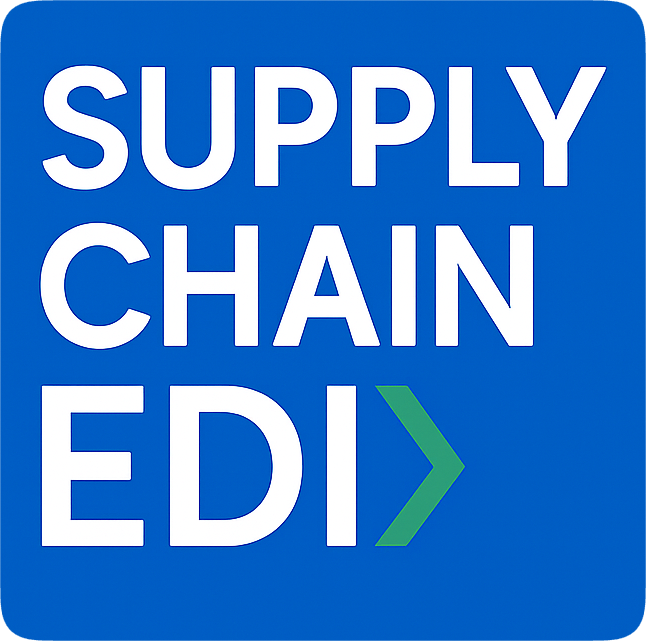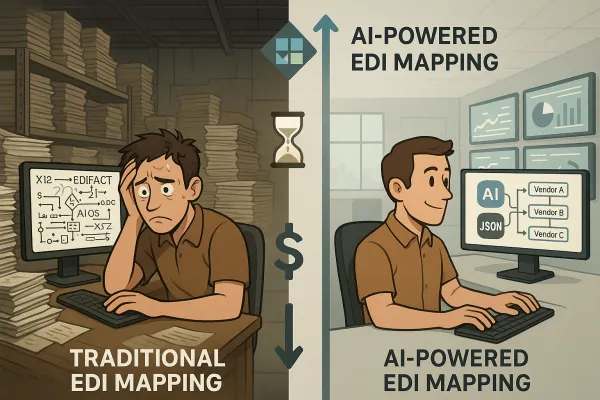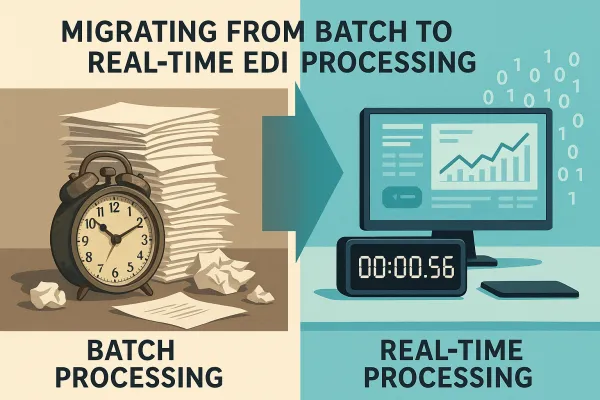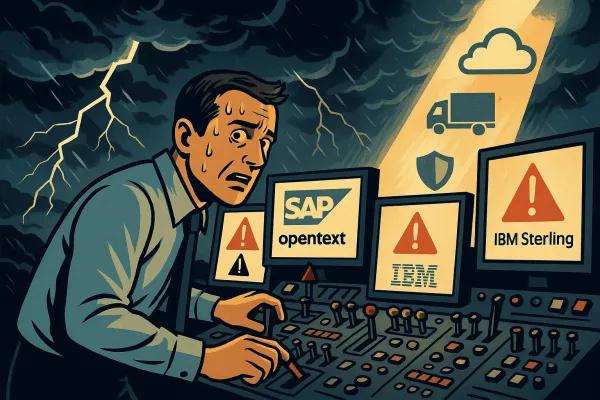The EDI Workforce Crisis: Your Strategic 2025 Action Plan for Building Supply Chain Integration Talent When Traditional Hiring Fails
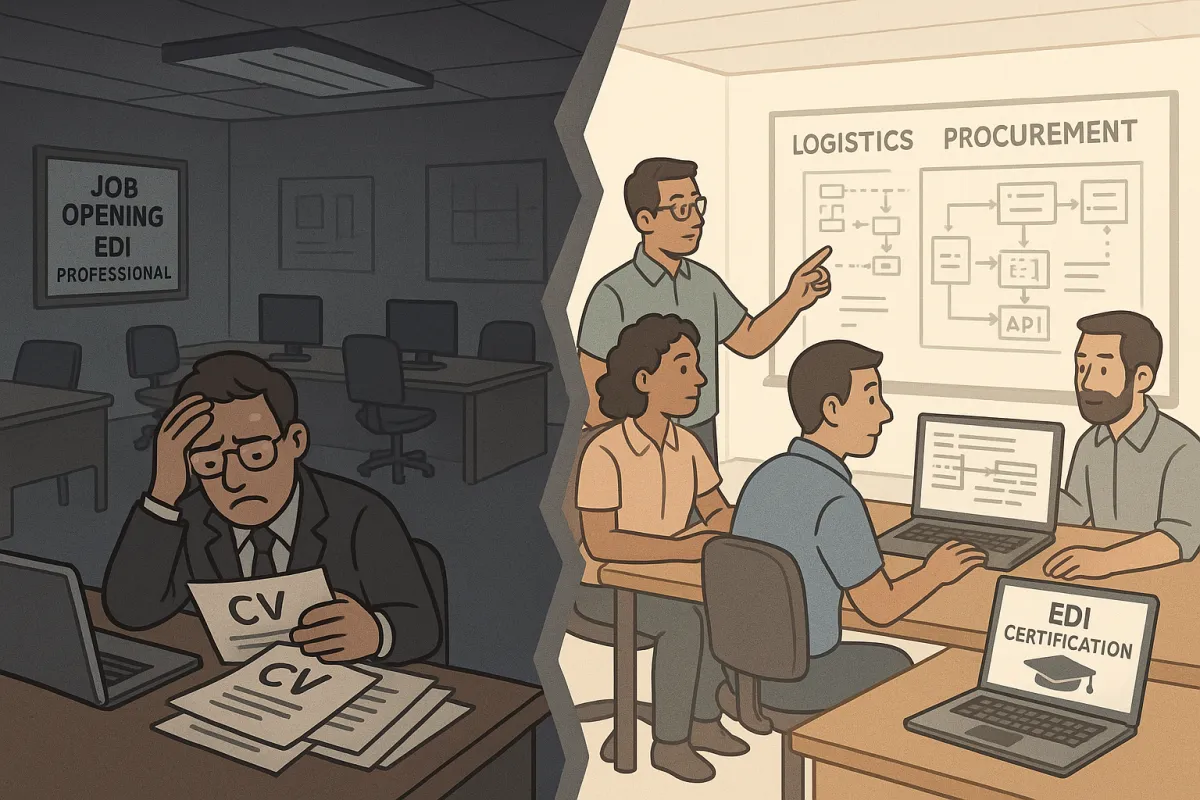
The numbers tell a stark story: 29% of businesses lack the skilled resources to build and manage integrations between systems, applications, and partner ecosystems, while the cost of inadequate cloud and integration skills alone reaches $258 million annually according to the London School of Economics. For supply chain leaders managing EDI operations, this EDI skills shortage isn't just another HR challenge — it's a business continuity crisis.
You've probably felt this pressure firsthand. Your existing EDI professionals are overwhelmed, new hires take months to become productive, and competitors are poaching your trained staff with salary offers you can't match. Meanwhile, trading partners demand faster onboarding, more complex integrations, and zero tolerance for errors. Sound familiar?
The Scale and Impact of the EDI Skills Crisis
The statistics paint a concerning picture. 85% of respondents reported moderate to extreme skills shortages, with procurement and logistics, and IT among the worst affected sectors. This isn't a temporary blip — it's the new reality.
What makes the EDI situation particularly challenging is the specialized nature of the skills required. Unlike general IT skills that transfer across platforms, EDI knowledge involves understanding specific document standards (X12, EDIFACT, TRADACOMS), mapping complex business rules, and troubleshooting partner-specific integration issues. Most EDI professionals learn on the job, picking up knowledge as they go, which makes it difficult to scale expertise across the industry.
The economic impact extends beyond just hiring costs. Unfilled positions create bottlenecks in productivity, leaving companies struggling to stay competitive. When your EDI team is understaffed, integration projects get delayed, partner onboarding slows down, and your existing staff burns out from the constant pressure.
Why Traditional Recruitment is Failing EDI Organizations
The fundamental problem isn't just scarcity — it's a perfect storm of factors that make traditional hiring approaches obsolete for EDI roles.
First, there's the aging workforce issue. Many of the professionals who initially implemented and managed EDI systems are now reaching retirement age, taking with them years of specialized knowledge and hands-on experience. These aren't skills you can easily replace by posting on job boards.
Educational institutions haven't kept pace. While many universities and technical schools offer degrees in information technology, computer science, and business management, EDI is rarely a focus of these programs. As a result, few graduates enter the workforce with a specific understanding of EDI systems, protocols, and standards.
The competition for scarce talent is driving costs through the roof. Companies are fighting over the same small pool of experienced professionals, leading to salary inflation that makes hiring prohibitively expensive for many organizations. Add in the fact that new hires often face a steep learning curve when it comes to understanding legacy systems and the complexities of EDI implementation and integration, and you've got a recipe for recruitment failure.
There's also a perception problem. Newer technologies such as APIs and blockchain are becoming more prevalent in supply chain management, leading to concerns that EDI will eventually be phased out or replaced. This perception may discourage younger professionals from pursuing careers in EDI, further contributing to the shortage.
The Strategic Reskilling Framework: Building Internal Talent
Rather than fighting for external talent, forward-thinking organizations are building their own EDI expertise from within. This requires a systematic approach that goes beyond traditional training programs.
Start by identifying transferable skills from your existing workforce. Your logistics coordinators already understand supply chain processes and document flows — they just need technical training. Your IT staff have the programming and troubleshooting skills but need business context. Your procurement team knows partner requirements intimately but lacks integration knowledge.
The key is creating personalized learning paths that leverage these existing strengths. Most training will be provided internally and much of it on the job, which aligns perfectly with how EDI knowledge is typically acquired. Develop a progression framework: basic EDI concepts → document standards → mapping and transformation → advanced troubleshooting → API integration.
Collaborations between businesses and academic institutions can create specialized EDI training courses or certifications as part of broader IT or supply chain management programs. These initiatives help equip the next generation with the skills needed to manage and evolve EDI systems.
Internal mentorship is critical. Investing in internal training programs and mentorship opportunities can help companies build a pipeline of EDI talent from within their own workforce. By pairing new hires with experienced professionals, organizations ensure valuable institutional knowledge is passed on.
Consider partnering with EDI platform vendors who offer comprehensive training programs. Many modern solutions like those from Cleo, TrueCommerce, SPS Commerce, and Cargoson provide not just software but complete learning ecosystems that can accelerate your team's development.
Alternative Staffing Models: Beyond Full-Time Hires
When full-time EDI professionals are scarce and expensive, alternative staffing models can provide the expertise you need while controlling costs.
Partnering with external IT companies reduces costs, overhead, and provides 24/7 coverage that understaffed and short-skilled IT and integration competency centers cannot. Outsourcing EDI integration skills means that competency is no longer an internal requirement for staff. This increases the reliability of digital business transactions, and provides more control over support and services engagement required to ensure successful migration and maintenance.
Hybrid teams work particularly well for EDI operations. Keep business analysts and project coordinators internal — they understand your processes and can manage partner relationships. Outsource the technical implementation, mapping, and troubleshooting to specialists who can work across multiple clients and maintain deeper technical expertise.
For smaller organizations, managed services provide complete EDI operations without the need for internal staff. Entrusting EDI operations to industry-leading managed services eliminates the need to scour hiring sites for skilled EDI professionals, reduces operational costs, and ensures compliance with trading partner requirements. In short, it helps businesses realize the promises of EDI without the burden on internal teams.
Contractor and consultant networks offer flexibility for project-based work. When you need to onboard new partners, implement system upgrades, or handle integration testing, specialized contractors can provide expertise without long-term commitments.
Many transport management platforms like Cargoson, nShift, and Transporeon have adapted their service models to work with various staffing approaches, providing training and support regardless of whether you have internal teams or rely on external resources.
Technology Solutions That Reduce Skills Dependency
The most effective long-term strategy for addressing EDI skills shortages involves implementing technology that requires less specialized expertise to operate and maintain.
Modern EDI platforms are designed with user experience in mind. Instead of requiring deep technical knowledge to create mappings or troubleshoot errors, these solutions provide intuitive interfaces, automated error detection, and guided workflows that business users can manage.
Look for platforms that offer pre-built templates for common trading partners and document types. When you can onboard a new retailer using a tested template rather than building mappings from scratch, you reduce both the time required and the skill level needed.
Low-code and no-code EDI tools are becoming increasingly sophisticated. These platforms allow business users to create and modify integrations using visual interfaces rather than traditional programming approaches. While they may not handle the most complex scenarios, they can manage a significant portion of routine EDI operations.
AI-assisted mapping and troubleshooting are game-changers. Modern platforms can analyze data patterns, suggest mappings, and even predict potential issues before they cause transaction failures. This technology effectively augments human expertise, allowing less experienced staff to handle complex scenarios.
Custom dashboards and automated monitoring reduce the need for constant manual oversight. When systems can automatically detect and alert on issues, your team can focus on exception handling rather than routine monitoring.
Comprehensive transport management systems like Cargoson integrate EDI functionality with broader logistics operations, reducing the complexity that comes from managing multiple point solutions. This approach requires fewer specialized skills while providing better visibility across your entire supply chain.
Building Your 2025 EDI Workforce Development Strategy
Creating an effective workforce development strategy requires a systematic approach that balances immediate needs with long-term sustainability.
Begin with a comprehensive skills assessment. Map your current team's capabilities against your operational requirements and future growth plans. Identify critical gaps that could impact business continuity if not addressed quickly. Don't forget to assess soft skills — communication, problem-solving, and business acumen are often more important than technical expertise.
Calculate the ROI for different approaches. Internal training might cost $15,000-25,000 per person over 12 months but provides long-term value. Outsourcing could cost $8,000-12,000 monthly but offers immediate expertise and scalability. Hybrid approaches often provide the best balance, combining internal business knowledge with external technical capabilities.
Develop realistic implementation timelines. Internal skill development takes 12-18 months to show significant results. Outsourced solutions can be operational within 30-60 days but require time to understand your specific processes. Plan for overlap periods where both approaches run in parallel to ensure smooth transitions.
Establish clear success metrics. Track productivity indicators like partner onboarding time, error rates, and time-to-resolution for issues. Monitor employee engagement and retention — if your reskilling efforts are creating stress rather than building capabilities, you need to adjust your approach.
Consider how your technology choices support workforce development. Modern platforms that provide better training resources, clearer interfaces, and stronger support can significantly reduce the time needed to build internal competency.
Future-Proofing Your EDI Talent Investment
The most successful organizations are those that prepare their teams for ongoing change rather than just solving today's immediate skill gaps.
Focus on developing judgment and critical thinking skills that can't be automated. While AI can suggest mappings and identify errors, human professionals still need to understand business contexts, make decisions about exception handling, and communicate with trading partners.
Cross-train your team between EDI and API integration. The future of B2B integration involves hybrid approaches where traditional EDI documents flow through modern API infrastructures. Professionals who understand both domains will be far more valuable than those who specialize in just one area.
Build a learning culture that embraces continuous adaptation. More than half of all employees around the world need to upskill or reskill by 2025 to embrace new responsibilities driven by automation and new technologies. Organizations that make learning a core part of their culture will adapt more successfully to ongoing changes.
Implement succession planning for critical EDI roles. Don't let institutional knowledge walk out the door when key people leave. Document processes, create knowledge bases, and ensure multiple people understand critical integration points.
Investing in comprehensive platforms like Cargoson provides long-term value compared to cobbling together multiple point solutions. When your technology stack is simpler and more integrated, your team can focus on business value rather than system management.
The EDI skills shortage isn't going away anytime soon, but organizations that take a strategic approach to workforce development will emerge stronger. Whether you choose to build internal capabilities, partner with external specialists, or implement technology that reduces skill dependencies, the key is starting now. Every month you delay makes the problem more expensive to solve and gives competitors who act decisively a bigger advantage.
Your next step should be conducting that skills assessment and calculating the ROI for different approaches. The data will guide your decision, but the urgency of the situation demands action. The question isn't whether you need to address EDI workforce challenges — it's which approach will deliver the best results for your specific situation.
